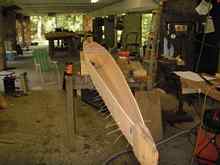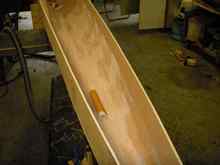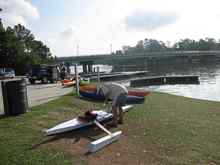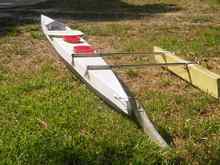
 Custom Search
|
|
| sails |
| plans |
| epoxy |
| rope/line |
| hardware |
| canoe/Kayak |
| sailmaking |
| materials |
| models |
| media |
| tools |
| gear |
 |
 |
| join |
| home |
| indexes |
| classifieds |
| calendar |
| archives |
| about |
| links |
| Join Duckworks Get free newsletter Comment on articles CLICK HERE |
|
|
| A Journey Off to One Side |
by Skip Johnson - Houston, Texas - USA |
IntroductionThis missive came about because a couple of Duckwork Forum members asked me to expound on how I had "missed the mark" so far in this particular endeavor. I'd like to disabuse anyone of the notion that any of the boat stuff I play with springs into being perfectly formed and without fault. EasyB is the first boat of mine ever to be close enough to right to be duplicated as is (3 times so far) and EasyB followed in the wake of a dozen or more similar canoes built by yours truly and others. Every one a good boat; they all whispered a bit about how it would be better if only... There's a similar tale behind double and single blade paddles, multiman Safari boats, and all the other slightly oddball stuff I find so fascinating. The joy is in the journey. Let me hasten to add that those boats designed for others are always done with best effort possible to hit the mark requested, if I don't think that's possible, the boat is not done. For my own boats though... read on. A journey off to one sideThis particular journey started around 7:20 Am Saturday, July 24, 2010 at the start of a practice run from Bastrop to Smithville for that years Colorado 100 canoe race. Since I had started doing the race solo in EasyB, Susie, wife and team captain, aka Super Shuttle Bunny has (quite reasonably) insisted that I do practices when other paddlers are on the river. Most of the other demented souls have to run a shuttle for these practices but with Susie in tow I can put in well ahead of most of the other paddlers and the quicker more competitive paddlers will eat up my hour's head start before the 25 mile run is done. This particular morning I happened to glance back towards Fisherman's Park as EasyB passed under the Hiway 71 Bridge. It was a fateful moment. We were travelling at about hull speed plus current probably 5 mph (4+1). The morning Sun was just right to highlight the wake behind EasyB and I thought "huh, that's a lot of water to drag down the river" followed by random musing about the Texas Water Safari race boats that I'd designed over the years and how they didn't drag such wakes behind them. There are perfectly valid reasons for the difference in wakes mainly having to do with the difference between a 14' long canoe and a 40'+ one. Paddling in solitude with something on my mind can be risky. The steady rhythmic motion of a double blade paddle quiets some of the background noise of life and cogitation commences. How to make a solo boat for a fat old man that doesn't make a wake? Can't be too long, that makes for too much surface area. Has got to be skinny but if it gets very skinny I'll be swimming most of the time. I'll put an outrigger on it and the training wheel will keep it upright. As long as it's going to have an outrigger let's throw out all the form stability and have a semicircular cross section. This is a pretty experimental setup; ought to be done pretty down dirty and cheap. This could be done stitch and glue all the underwater sections identical, making a surface of revolution with 6 to 8 segments. Two joints of 5mm underlay ply and scrap cedar end caps makes about a 17'-4" boat. All this cogitation happens in the first few miles and then I'm able to put these musings to the side and enjoy the rest of the run. After pulling out at Smithville I tell Susie I've had an epiphany and am going to build a quick and dirty boat for this years' Colorado 100 some 6 weeks hence. Her predictable response is that once again I'm out of my ever loving mind. "But Dear, it's going to be a quick and dirty boat, I can do this". Yeah right.
The design fleshes out quickly (it is after all a quick and dirty boat), 17'-4" overall, 12-1/2" beam semicircular section, pretty simple. Of course there's no way my behind is going to fit in a 12" wide slot so I'll be comfortably sitting on top of this assembly and my feet will just barely fit in a footwell. The really big unknown is the outrigger. I had designed and built a high-tech ultra-light fishing kayak Karankawa with folding outriggers for Will Myer a few years ago. Karankawa was surprising stable with one float folded up to the boat and I'd tried to convince Will to use the boat with only one float but he wisely declined and went out to enjoy his boat as originally intended. I'm pretty sure one float will work, I'm just not too sure exactly how big and what shape it wants to be so we'll work it out on the fly. Construction begins the last of July. 24" wide plywood strips are butt scarfed together with a little lightweight cloth. 16' long panel is ripped into eight pieces nominally 3" wide. 6 pieces are pinned together and shaped into a parabolic gore shape. Hindsight being what it is, I should have spent a little more time getting these pieces really fair since the least little bit of unevenness is magnified when the pieces are stitched together. Still quick is the order of the day and bondo comes to the rescue for filleting the inside. Lightweight premium gold bondo is quite a nice product, quick curing, easy shaping, this may all work. A really handy tool for shaping the inside fillets is a piece of 80 grit psa sanding disk stuck to a piece of pvc pipe. By Friday the hull is all stuck together and the back deck is in place. Ah, but it's taken some long rushed hours and Saturdays practice paddle from Smithville to Lagrange kicks my butt. It is the first time ever that I had to switch to a single blade because I'd completely run out of steam. It turns out there is a limit to how much I can do and the paddling proa is relegated to being campaigned the following year. Before the boat is completely set aside, the inside is covered with lightweight glass fore and aft with a piece of 5 oz Kevlar in the cockpit area. Decks on, a half-gallon of bondo takes some of the unfairness out and boat hull is skinned with a layer of hybrid Kevlar-glass cloth.
The following year sneaks up quickly, the psychic and physical pain from the 2011 Texas 200 have faded and it's time to finish the paddling proa. What's left to do is outrigger float and beam, rudder system, seat and finish. Finish follows the quick and dirty theme. Bottom is coated with graphite epoxy (to better bounce off of rocks) and balance of hull is painted some Gripit primer followed by polyurethane porch enamel.
Rudder..., excuse me while I step up on my soapbox for a minute. There is no doubt in my mind, based on experience that a nice NACA sectioned (0012 or similar) rudder provides the best lift/drag ratio and beats a flat plate rudder all to heck. But in the knarly world of overhung pop-up rudders operating in the turbulent flow of a hard sweeper (turn in the river) that same nice rudder can and will quit working usually at a particularly inconvenient time having to do with large rocks, menacing tree limbs or other boats. Stall, cavitation, ventilation, whatever you want to call it, the effect is the same; that nice side motion that has been swinging the stern around has been replaced by a brake. My preference now is to use a scimitar or half a tuna fin shaped rudder which won't work quite as well as the straight NACA section but will keep working no matter what, it will gurgle and apply a little brake if you really push it but it's still swinging the stern around. Another idea not yet conclusively proved is to slope the rudder hinge line forward; the idea being to lift the stern a bit and lower the bow enhancing the turn. Off the soapbox. Regarding outriggers... I don't have a clue. Karankawa's floats were designed to always have a bit in the water and to never slap the water or make noise. OC1 and other surfski style outriggers have floats that have evolved to work well in an environment far removed from a Texas river. Back somewhat to first principles; float needs to be out of the way of paddle, it will go back towards the stern in this case. Leaning towards the float creates enough moment that somewhere around 12# of buoyancy is needed to keep things upright; starting out with more is probably not too bad an idea. Shape? I finally decide on a hull similar to a destroyer would be best place to start, speed length ratios are similar. I'm not sure why I decided to go with a single composite aka (beam) instead of a pair of more traditional tubes, part of the decision may have been based on the fact that I had all the materials at hand for the composite piece. Plus it looked neat. The composite ama was fabricated from a couple of layers of ½" klegecell capped top and bottom with some unidirectional eglass spar cap material used by the homebuilt aircraft crowd. All this was skinned with some bidirectional 6 oz eglass for torsional stiffness. The float itself was laminated up from some extruded blue insulation foam and left fairly rough until some of the trim issues were worked out. Test time, it's fairly easy to get Susie to tag along on the initial trial to take some pictures, she enjoys a good laugh as much as anyone. On to Lake Woodlands, fairly close, good access, restrooms etc. but there's not been any rain to flush out the system for many months and the water is getting pretty skanky - oh well. Put boat in the water, straddle, sit down gingerly, sit for a moment, this isn't too bad. So paddle away from ramp but stay close to shore to minimize length of recovery swim (I'm not ready to practice remounting just yet). First fairly hard right turn (to stay close to shore) and whap I'm swimming. No big deal, short swim, get recombubilated and try again. This really isn't too bad; just remember to bias weight a little bit towards float when turning right. Rudder works fairly well, even though it's just a square cut plate at the moment (with a nice scimitar profile). When boat speed picks up a little bit there's some noise from the float but I'm neither flexible nor comfortable enough yet to look over my shoulder to see what's going on. Fortunately there's not a lot of rudder correction to go straight so float drag's probably not a deal killer. I stop for a minute and get Susie's camera setup to take some video and make another run parallel to shore.
Splash. This time I know what's happened before I hit the water, I'm floatless, twitch to the left and whap to the right. The elastic band float mounting, similar to a model plane's wing attachment, has failed. Time to call it a day. Later, looking at the video it seems the float attachment is flexing and burying the bow of the float, but further study including twisting the darn thing as it sits on sawhorses downstairs shows that it is beam flex in torsion that is the culprit. What to do. I decide a quick and dirty fix is to wrap the composite beam with some diagonal carbon tow and try again. All these decisions are a blend of "what do I have on hand?" and "how long will it take?" with a dash of "is this quick and dirty enough?" Diagonal wrap done along with cleaning up the rudder section, slightly improved rudder pedals and then it's back to the water. Susie's already been entertained so I take the boat solo to a closer detention pond, no facilities but actually much cleaner water. Put boat in the water, straddle, sit down gingerly, oops this isn't working. Stability has vanished. After several attempts to get comfortable, I give up and pull the boat out of the water. A very cursory inspection shows what the problem is. With the diagonal carbon tow keeping the beam from flexing the unidirectional eglass has failed as evidenced by a number of parallel white lines in the upper compressive surface making for a fairly effective hinged beam which doesn't do squat for keeping the boat upright. Damn. I should have just used a couple of tube supports. All these beam flex issues, both torsion and bending, begin with me conveniently forgetting that the epoxy system I'm currently using takes quite a while (weeks at least) to reach anything resembling its ultimate strength. It's totally unreasonable to expect the epoxy to take a full load the next day, or the day after that. What to do? Colorado 100 race is going to be here in a matter of weeks and I'll need most of that time to train and get comfortable in a new unproven boat. Back to a parallel tube support system. There's some 1-1/8" diameter aluminum tubing at hand and some 1" aluminum tubing should be available locally. 1" tubing is available locally but it cost two and a half times as much as an online order, ouch. But there's no time to waste, an 8' piece of 1" aluminum tubing cost about as much as all my out of pocket expenses so far (2 sheets of underlay plywood and a gallon of bondo). 1-1/8" aluminum tubing sockets are bondod to hull and then tied into place with some unidirectional basalt tow wrapped over the ends. Float is modified to fill in old single saddle and two semicircular saddles for the aluminum tubes are added. Back to the water. Finally, everything kind of falls into place, without me falling into the water. Boat is surprisingly stable and the relatively high seating position makes for good vision forward, there being very little boat in front of paddler. A couple of miles up and down the detention pond and it's time to assess what we're going to do. First some cushioning for the seat is imperative, sitting on a flat piece of plywood for 100 miles is not going to happen. Second, it appears that the float would be a little happier with the bow up just a bit more but overall seems to be about right. Back home the seat is padded, more can be added if needed plus I've got an inflatable cushion to top things off. Front float saddle mount is reshaped and overall float is cleaned up to where it almost looks boatlike. Back to the water, GPS in hand this time. A couple of nice sustained runs are made, still no swimming involved but I am still being a little careful. But while top speed is way higher than EasyB, sustained cruising speed is just higher. EasyB can comfortably cruise at about 4 mph (flatwater) with its current motor and the new boat is cruising at about 4.4+mph for about the same effort in the same conditions. This isn't enough, the extra speed translates into saving about 2 hours in a 20 hour run and that doesn't seem like it's worth the risk of not finishing. I originally had visions of saving four hours, a totally different balance of value judgments. One last time, since we aren't making much wake, the majority of drag is skin friction and finish is pretty crude. So a quick round of scrape and recoat the graphite bottom will probably help. Scraping is ordained since the Kevlar in the hybrid fabric skin is just waiting to fuzz up as soon as a piece of sandpaper shows up in the neighborhood. With the bottom a little less rough (faint but honest praise) another trip to the pond is made. Boat is quicker, but still not near quick enough. A sneaking suspicion creeps in that there may be a fundamental problem with the motor which continues to pass tech inspection but does have a lot of miles and years on it.
So this year it's back to doing the Colorado 100 in EasyB, about a 20 hour run, depending on current, wind, etc., which is fine. The paddling proa will probably be dusted off later and played with some more to wring a little more information out of it (unless I find a new home for it). There may or may not be a Mark 2, but at least I've got a baseline to work from. |












